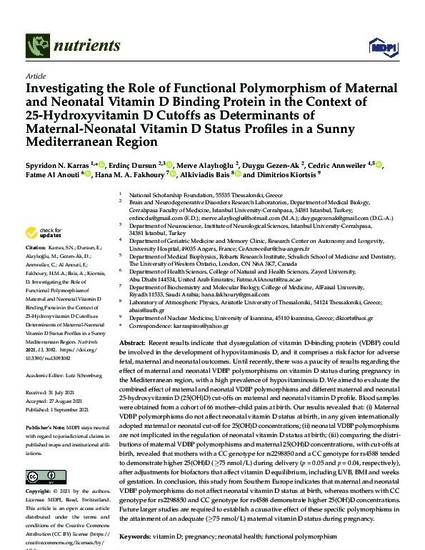
Recent results indicate that dysregulation of vitamin D‐binding protein (VDBP) could be involved in the development of hypovitaminosis D, and it comprises a risk factor for adverse fetal, maternal and neonatal outcomes. Until recently, there was a paucity of results regarding the effect of maternal and neonatal VDBP polymorphisms on vitamin D status during pregnancy in the Mediterranean region, with a high prevalence of hypovitaminosis D. We aimed to evaluate the combined effect of maternal and neonatal VDBP polymorphisms and different maternal and neonatal 25‐hy-droxyvitamin D (25(OH)D) cut‐offs on maternal and neonatal vitamin D profile. Blood samples were obtained from a cohort of 66 mother–child pairs at birth. Our results revealed that: (i) Maternal VDBP polymorphisms do not affect neonatal vitamin D status at birth, in any given internationally adopted maternal or neonatal cut‐off for 25(OH)D concentrations; (ii) neonatal VDBP polymor-phisms are not implicated in the regulation of neonatal vitamin D status at birth; (iii) comparing the distributions of maternal VDBP polymorphisms and maternal 25(OH)D concentrations, with cutoffs at birth, revealed that mothers with a CC genotype for rs2298850 and a CC genotype for rs4588 tended to demonstrate higher 25(OH)D (≥75 nmol/L) during delivery (p = 0.05 and p = 0.04, respec-tively), after adjustments for biofactors that affect vitamin D equilibrium, including UVB, BMI and weeks of gestation. In conclusion, this study from Southern Europe indicates that maternal and neonatal VDBP polymorphisms do not affect neonatal vitamin D status at birth, whereas mothers with CC genotype for rs2298850 and CC genotype for rs4588 demonstrate higher 25(OH)D concen-trations. Future larger studies are required to establish a causative effect of these specific polymor-phisms in the attainment of an adequate (≥75 nmol/L) maternal vitamin D status during pregnancy.
- Functional polymorphism,
- Neonatal health,
- Pregnancy,
- Vitamin D
Available at: http://works.bepress.com/fatme-alanouti/29/
